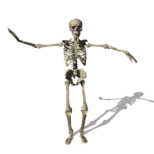Talk:Bone Histology
Practical Audio
Files below are Quicktime audio files recorded 2009 Wednesday 12 - 2 PM class (Podcast MP3 versions to follow).
Part 1 - Adult Bone Structure | Part 2 - Bone Structure | Part 3 - Developing Endochondral Ossification | Part 4 - Developing Intramembranous Ossification
- MH - Please note "perichondrium" instead of "periosteum" error somewhere in the above audio. Open in a separate tab to play the audio in the background.
2014
Vascularization of primary and secondary ossification centres in the human growth plate
BMC Dev Biol. 2014 Aug 28;14(1):36. [Epub ahead of print]
Walzer SM, Cetin E, Grübl-Barabas R, Sulzbacher I, Rueger B, Girsch W, Toegel S, Windhager R, Fischer MB.
Abstract
BackgroundThe switch from cartilage template to bone during endochondral ossification of the growth plate requires a dynamic and close interaction between cartilage and the developing vasculature. Vascular invasion of the primarily avascular hypertrophic chondrocyte zone brings chondroclasts, osteoblast- and endothelial precursor cells into future centres of ossification.Vascularization of human growth plates of polydactylic digits was studied by immunohistochemistry, confocal-laser-scanning-microscopy and RT-qPCR using markers specific for endothelial cells CD34 and CD31, smooth muscle cells ¿-SMA, endothelial progenitor cells CD133, CXCR4, VEGFR-2 and mesenchymal progenitor cells CD90 and CD105. In addition, morphometric analysis was performed to quantify RUNX2+ and DLX5+ hypertrophic chondrocytes, RANK+ chondro- and osteoclasts, and CD133+ progenitors in different zones of the growth plate.ResultsNew vessels in ossification centres were formed by sprouting of CD34+ endothelial cells that did not co-express the mature endothelial cell marker CD31. These immature vessels in the growth plate showed no abluminal coverage with ¿-SMA+ smooth muscle cells, but in their close proximity single CD133+ precursor cells were found that did not express VEGFR-2, a marker for endothelial lineage commitment. In periosteum and in the perichondrial groove of Ranvier that harboured CD90+/CD105+ chondro-progenitors, in contrast, mature vessels were found stabilized by ¿-SMA+ smooth muscle cells.ConclusionVascularization of ossification centres of the growth plate was mediated by sprouting of capillaries coming from the bone collar or by intussusception rather than by de-novo vessel formation involving endothelial progenitor cells. Vascular invasion of the joint anlage was temporally delayed compared to the surrounding joint tissue.
PMID 25164565
2007
Endochondral ossification: how cartilage is converted into bone in the developing skeleton
Int J Biochem Cell Biol. 2008;40(1):46-62. Epub 2007 Jun 29.
Mackie EJ1, Ahmed YA, Tatarczuch L, Chen KS, Mirams M.
Abstract
Endochondral ossification is the process by which the embryonic cartilaginous model of most bones contributes to longitudinal growth and is gradually replaced by bone. During endochondral ossification, chondrocytes proliferate, undergo hypertrophy and die; the cartilage extracellular matrix they construct is then invaded by blood vessels, osteoclasts, bone marrow cells and osteoblasts, the last of which deposit bone on remnants of cartilage matrix. The sequential changes in chondrocyte behaviour are tightly regulated by both systemic factors and locally secreted factors, which act on receptors to effect intracellular signalling and activation of chondrocyte-selective transcription factors. Systemic factors that regulate the behaviour of chondrocytes in growth cartilage include growth hormone and thyroid hormone, and the local secreted factors include Indian hedgehog, parathyroid hormone-related peptide, fibroblast growth factors and components of the cartilage extracellular matrix. Transcription factors that play critical roles in regulation of chondrocyte gene expression under the control of these extracellular factors include Runx2, Sox9 and MEF2C. The invasion of cartilage matrix by the ossification front is dependent on its resorption by members of the matrix metalloproteinase family, as well as the presence of blood vessels and bone-resorbing osteoclasts. This review, which places an emphasis on recent advances and current areas of debate, discusses the complex interactions between cell types and signalling pathways that govern endochondral ossification. PMID 17659995
